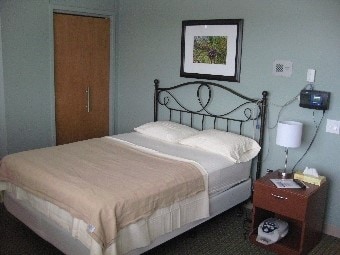Preparing for your Sleep Study
Comfortable Overnight Accommodations for Testing & Diagnosis
 Sleep disorders can be diagnosed with a thorough exam from a pulmonologist or otolaryngologist (ear, nose, throat, head and neck (ENT) surgeon). This may be followed up with a sleep study to determine the severity of the problem and course of treatment. Sleep studies are performed in the Silver Cross Sleep Disorders Center, located in Pavilion A, Suite 525 on the Silver Cross Hospital campus. Most health plans are accepted.
Sleep disorders can be diagnosed with a thorough exam from a pulmonologist or otolaryngologist (ear, nose, throat, head and neck (ENT) surgeon). This may be followed up with a sleep study to determine the severity of the problem and course of treatment. Sleep studies are performed in the Silver Cross Sleep Disorders Center, located in Pavilion A, Suite 525 on the Silver Cross Hospital campus. Most health plans are accepted.
Evaluation Room
Each spacious private room has a bathroom, calming décor and comfortable bed to put you at ease. At the Silver Cross Sleep Disorders Center, technologists perform polysomnographic testing, and sleep studies that provide a detailed picture of your entire sleep cycle. The studies allow technicians to analyze your exact sleep pattern, from the onset of sleep through the 5 normal levels of sleep, to your breathing, oxygen levels, heartbeat, movement and snoring activity. Data from the study is invaluable in diagnosing and treating any sleep disorder you may have. The morning following your sleep study, our experts will begin to analyze your results. Some patients may begin treatment as soon as the same day.
What to Do Before Your Sleep Study?
- Please arrive with clean, dry hair.
- Do not use gels, lotions or oils on your scalp or skin.
- Do not nap during the day of your study.
- Do not drink excessive amounts of caffeine after noon on the day of your study.
- Be sure to bring your favorite pillow and blanket to help you relax. We provide them as well.
- Wear comfortable pajamas, T-shirt, sweatpants or shorts.
- Bring your evening medications.
- Bring your toiletries for an overnight stay. A private bathroom/shower is available.
What is a Sleep Study Like?
- Typically, you arrive at the Sleep Disorders Center in the evening.
- A trained, professional sleep technologist will greet you in the waiting area.
- After the technologist gives you a brief tour of the sleep center, you will be escorted to your private room to change into your sleep attire.
- The technologist will discuss everything that will happen during your study and answer any questions you have about this painless and non-invasive procedure.
- The technologist will help you complete paperwork to assess your level of sleepiness before the test begins, as well as insurance company paperwork.
- Leads will be placed on your scalp using a water-soluble paste to monitor your brainwave activity. We will monitor your leg movements, eye movement, snoring, oxygen levels, cardiac rhythms, respiratory effort and nasal/oral airflow.
- You will not be injected with anything. Sensors are applied using stickers, tape adhesive or water-soluble paste.
- Almost everyone can fall asleep, although it may take a little longer than usual. We attach the monitoring devices when you arrive and allow time for you to sit, relax and read or watch TV before start the sleep study. This will allow you time to get accustomed to the feeling of the leads and wires.
What to Expect During a Sleep Study
- While you are sleeping, the technologist will be continually monitoring your sleep waves and
vital signs throughout the night.
- The technologist will be able to hear you call out from the bedroom. If you need to get up to use the private bathroom in your room, the technologist can disconnect two cables that will allow you to move around. A urinal may be placed bedside upon request.
- If you demonstrate any severe breathing difficulties during sleep, the technologist may intervene.
What Can You Expect After Your Sleep Study?
- Once your sleep study is analyzed and scored by the sleep technologist, the results are shared with your doctor. He/she will interpret the data and share the results with you during your next visit.
- During your follow-up visit, the doctor will discuss your diagnosis and prescribe the treatment or medications that will work best for you to help you enjoy a good night’s sleep.
Watch Video on What to Expect with Your Sleep Study
Download Our Sleep Study Guide and FAQs